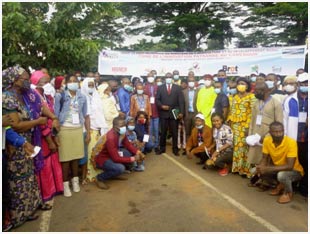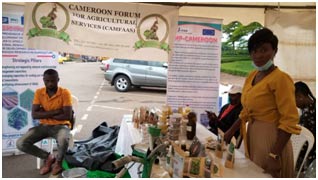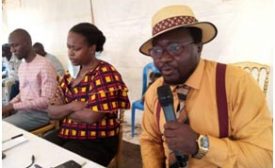Introduction

The Food and Agricultural Organisation (FAO) defines agricultural innovation as “the process by which individuals or organisations implement new or existing products, processes or organisational arrangements in a specific context to improve efficiency, competitiveness, resilience or environmental sustainability, thereby contributing to food security and nutrition, economic development and sustainable management of natural resources”.
A local innovation fair at national level was organised not only to showcase farmers’ creativity; it also served as a tool for advocacy and lobbying to open doors preventing farmers from being involved in ARD processes that seek solutions for their problems. And it is an opportunity for information and technology sharing meetings, exchanges and networking between farmer innovators – men, women and youth – from various areas.
Held on 27–29 May 2021, The FIPAC was coorganized by The Cameroon Forum for Agricultural Advisory Services (CAMFAAS), in collaboration with various partners. These include the k Promoting local Innovation in ecologically oriented agriculture and natural resource management (PROLINNOVA), MISEREOR / KZE (Germany) and (COSADER). The objective to attract ARD stakeholders and select farmer innovators from the ten administrative regions of Cameroon to take part.
Methodology
Eligibility: Participants were selected among all Cameroonian family farmers who developed their own local innovations in the fields of crop farming, horticulture, livestock husbandry, agroforestry, fishery, storage and processing of plant and animal products, biodiversity conservation and climate change adaptation in agro-ecological production. The farmers may be gardeners, small-scale crop farmers, agropastoralists or pastoralists as well as people who have innovated in the agro-sylvo-pastoral and fisheries sectors, including urban farmers. The innovations can be technical, organisational, institutional or social.
Selection: Innovation were selected at local levels by regional committees, ranked then sent to the general FIPAC coordination. Base on those ten lists, the scientific committee selected and published a list of 50 farmer innovators, five from each region, who therefore participated to the FIPAC.
The selection process was implemented with a particular attention on women, youth and people in conflict areas of age according to the followings:
- Originality with respect to customary practice;
- Relevance for low-external-input small-scale ecologically oriented farming (no negative impacts on the environment, regenerative in nature, recycling of resources etc.);
- Ease of use by the innovator(s) and by others wanting to try it out;
- Contribution to or potential impact of the innovation for local development;
- Acceptability of the innovation by other local farmers from a social and cultural point of view.
The regional committees helped the innovators to prepare their presentations (posters, documents, videos, objects…) for the event. In addition they were able to prepare the costs of the selected innovators for accommodation, food and transport to and from Yaoundé which was covered by the FIPAC organizing committee.
Outputs

From the communication around the event to the physical participation CAMFAAS showcased the practical aspect of its mission with documents used for trainings and advisory services as well as the innovations brought by the CF network members. From improved seeds to processed food, health and cosmetic products the value chain was covered. The event was covered live on the camfaas facebook page https://web.facebook.com/CAMFAAS/
Besides the practical innovations thematics on agroecology, agroecology and innovative integrated family farm systems, innovative agricultural and agri-food technologies in rural areas, farmers’ knowledge and introduced technologies and partnerships and agricultural innovations. #Nestor Ngouambe, Dr Marguerite Mbolo, Dr Cyndhia Mathé, Abdel-Karim Mahamane and Christine Andela

Communication is a key factor in making your innovation known. The quality of the innovation determines whether or not it is adopted by the producer. If you answer a specific problem and give satisfaction to the producer. Extension costs the government a lot of money, it should be possible to get producers to pay for agricultural advisory services in a competitive context. How do we improve the environment and the availability of innovations? It is important to address this issue before moving on to the question of financing.
Can agroecoly feed the population?
The population is all the family units, so if all the family units are fed in the rural area, then Cameroon is fed, let’s start by eating locally, our eru, our cocoyams, our kpem, our nuts, local fruits etc. we have enough to eat well, extremely rich food, lets take advantage of it.
Fourteen innovators were awarded by the Minister of Agriculture and Rural Development (MINADER)

